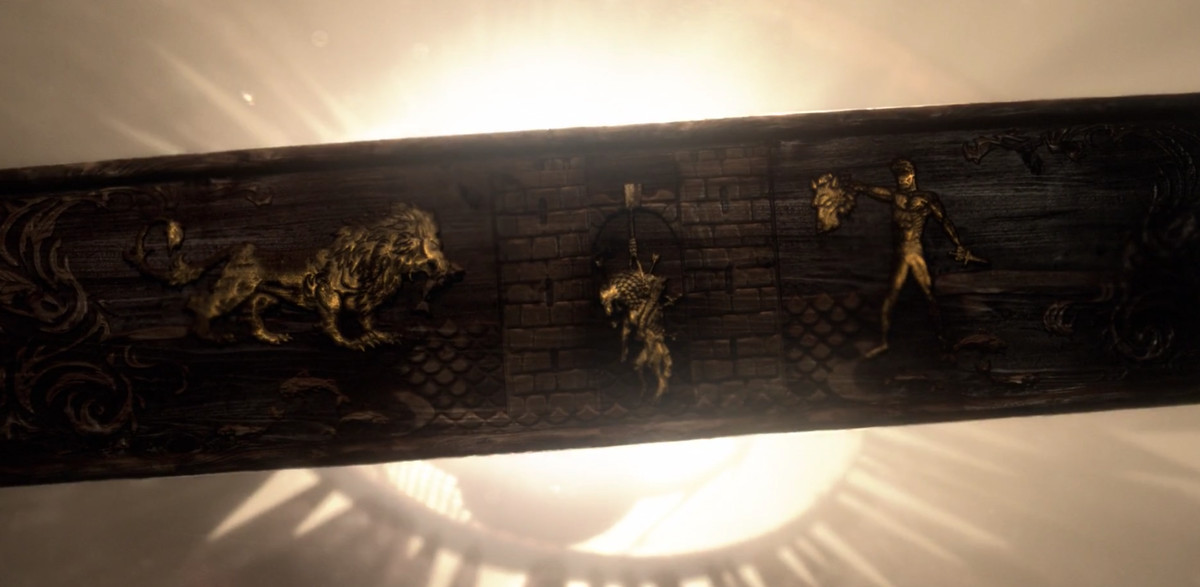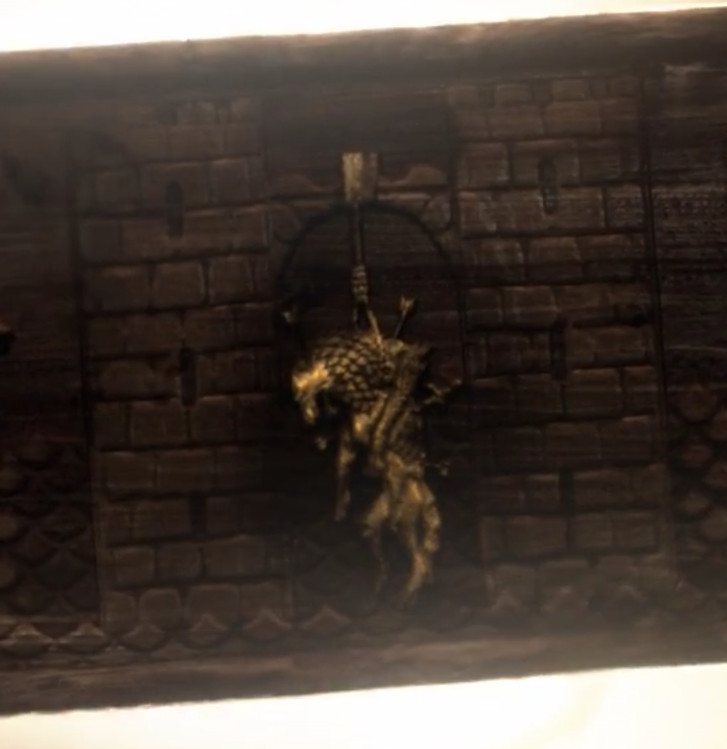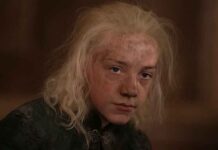Armies on the march! Dragons on the wing! Gratuitous sex scenes! Incest! Political intrigue! And ice zombies with no clear motivation! GAME OF THRONES IS BACK! The eighth and final season is upon us like a poxy whore discussing the loot train attack! So, as Bran Stark might say, let’s not waste any time. On to your questions!
Mo asks, “What’s the deal with the Golden Company?”
The Golden Company is the premier sellsword outfit in Essos. They, famously, have never broken a contract, a claim that reads increasingly like the branding version of Chekhov’s gun. Most mercenary groups are poorly disciplined, rough-and-tumble scrappers with dodgy equipment and a penchant for betrayal. Think of our introduction to Daario Naharis (v 1.0) and his Second Sons back in Season 3. Yunkai hired the Sons to defend the city against Daenerys and her newly acquired Unsullied. Rather than risk a confrontation, Dany attempts to buy off the Second Sons, but they spurn her. But one of their captains, Daario, is so taken by the young Targaryen queen that he murders his cocaptains and delivers their heads to Dany in a bag. You hate to see it.
The Golden Company, on the other hand, is well equipped. They’re some 20,000 strong, their camps are laid in an orderly fashion, and, on the battlefield, they perform with the precision of a professional military. In the books, they were founded by Aegor Rivers, known as “Bittersteel,” nearly 80 years before the events of the show. Bittersteel was one of the so-called “Great Bastards,” the bastard sons of King Aegon IV Targaryen, known as “Aegon the Unworthy” because he was a disaster of a sovereign. On his deathbed, Aegon legitimized his bastards, setting the table for a series of civil wars known as the Blackfyre Rebellions.
After House Targaryen prevailed over the Blackfyres at the decisive Battle of the Redgrass Field—with Brynden Rivers, before his days as the Three-Eyed Raven, and his archers, known as the Raven’s Teeth, playing a central role—Bittersteel (carrying Blackfyre, the Valyrian sword of Aegon the Conqueror and the late Daemon Blackfyre) and many other survivors fled to Essos. Armed men have little trouble finding employment in the east, where the Free Cities of Lys, Myr, and Tyrosh have been fighting a long-running war over an area of the continent called the Disputed Lands. Bittersteel initially joined the Second Sons—Daario’s future crew. But as he watched support for House Blackfyre melt away and the refugee lords and knights join up with various sellsword groups, he grew dispirited. Bittersteel dropped out of the Second Sons and founded the Golden Company as a way to keep the Blackfyres together. They quickly established themselves as the most formidable and reliable mercenary company in Essos. But their goal was always to one day return to Westeros.
It will be interesting to see what motivations, beyond fulfilling their contract, the show version of the Golden Company has. Harry Strickland, the Golden Company’s leader, is known as Homeless Harry in the books. He, like many of his soldiers, is descended from a family that lost its lands and titles for supporting the losing side of the Blackfyre Rebellion. Does the show version of the Golden Company share the same Westerosi-Blackfyre lineage? Do they still covet the lands and ancient rights that were stripped from their forebears? Is this invitation to sail west the opportunity they’ve been waiting several generations for? And does the Golden Company still have Blackfyre, the sword of Aegon the Conqueror?
One more wrinkle! In the books, the Golden Company gets caught up in a scheme to place Young Griff—a young man purporting to be Aegon Targaryen, the son of Rhaegar and Elia Martell, thought murdered during the sack of King’s Landing but according to Griff and his supporters smuggled out of the capital—on the Iron Throne. They invade Westeros and cause much chaos around the Stormlands. I know there are only five episodes left. But I can’t believe Homeless Harry and the Golden Company would be introduced solely to follow Cersei’s orders then sail away.
Katherine H. asks: “We need an update on the slavers! We need to hear from Daario on how that shit is going in Slaver’s Bay! Will they be out for revenge? Will Cersei realize that she can hit them up for some support in hating on Dany?”
With five episodes left, I doubt we’ll spend much time in Essos. Unless it would be to check in on Melisandre and some magical item she’s bringing with her to Westeros to fulfill her destiny to die in “this strange country.” That said, I could see a world in which Daario, heartsick over Dany, slips out of Meereen to join up with the Golden Company once he hears they’re heading to Westeros!
Steven asks, “Since Jon rode Rhaegal, does that mean that Dany has got only one dragon now?”
Interesting question! The show has done quite a bit of retconning with regard to dragon-riding. In the books it is suggested, but by no means established, that Valyrian heritage is needed to ride a dragon. After all, Targaryens were just one of many noble dragonlord houses of Valyria, and a minor one at that. With this in mind, it’s possible that many other people could be dragonriders based on their Valyrian blood.
The show, however, has made being a Targ integral to dragon-riding. “Only a Targaryen can ride a dragon,” says showrunner David Benioff in the Inside the Episode featurette for “Winterfell.” This raises some interesting questions:
- Why doesn’t Dany, having no reason to suspect that Jon has Targaryen blood, react to Rhaegal’s acceptance of him? Dany is well versed in Targaryen history and lore. As children living on the streets of Essos, she and her brother Viserys had nothing to hold on to but their Targaryen identity. Did Dany not realize that Rhaegal’s acceptance of Jon as a rider suggests that he could therefore have Targaryen blood? She seemed perplexed at Drogon’s interest in Jon on Dragonstone in Season 7. Why not now?
- Did Dany believe that she was in control of Rhaegal when Jon was riding him? In the show, Dany’s bond with her dragons, particularly Drogon, is something akin to telepathy. For instance, in the books, when Drogon saves Dany from the Meereenese fighting pits, he’s drawn by the sound of battle and the smell of blood. In the show version, he seems to be drawn by Dany’s distress and mortal peril. Similarly, when Dany breaks the second siege of Meereen in Season 6, Rhaegal and Viserion break out of the holding pen under the pyramid seemingly at her call.
- To your question, Steven—who does Rhaegal answer to now? In the books, rider and dragon bond for life. (Well, life of the rider, that is. A dragon can take a new rider when its old one has died.) Drogon, for instance, will not accept another rider as long as Dany lives. It’s possible that, if this lore carries over to the show, Rhaegal is indeed Jon’s. Dany may be down to just Drogon.
Andrew, Sarah C., and others asked: “Thoughts on the new introduction? Along with the extra stuff at King’s Landing and Winterfell, there were new scenes on the globe thing?”
Those were fascinating! They represent iconic moments in the history of Game of Thrones.

Screenshots via HBO
This is Viserion, with the Night King on his back, bringing down the Wall. Note the army of the dead lined up underneath Viserion.

Here’s the Red Wedding. From left to right:

The Lannister Lion with a trout, the symbol of House Tully, in its mouth.

The Stark Direwolf hanging in the arches of the Twins, the seat and symbol of House Frey.

And the Flayed Man of House Bolton brandishing the head of a direwolf. Note the dead trout at his feet.

The final image on the astrolabe is the most difficult to figure out.
There are four dragons—one fully grown and three infants—facing west as a meteor streaks across the sky. This represents Daenerys Targaryen and the birth of her dragons.
As for the new scenes involving the Winterfell crypts and the basement levels of the Red Keep—those are more confirmation, as if we needed it, that the crypts of Winterfell will be central to our story moving forward. Both Winterfell and the Red Keep have important things—the bones of the Starks and the immense skulls of the Targaryen dragons, respectively—that pertain to Stark and Targaryen identity. Ice and Fire.
Grady asks, “What’s the deal with the White Walkers and that spiral shape?”
Showrunner David Benioff talked about these shapes in the Inside the Episode featurette for Season 7, Episode 4, “Spoils of War.” (LOOOOOOOOT TRAIIIIIIN.)
Benioff is explaining the scene where Jon shows Dany the cave paintings in the dragonglass mine under Dragonstone. The Children of the Forest created these cave decorations, which include spiral patterns just like those we’ve seen the White Walkers use. “One of the things we learn from these cave paintings,” says Benioff, “is that the White Walkers didn’t come up with those images. They derived them from their creators, the Children of the Forest.”
Benioff goes on to say that spirals patterns have significance in our world, therefore it makes sense that they would in the world of Game of Thrones. Whether he was simply being cagey, and downplaying the importance of the symbols to preserve a later reveal, certainly seems possible. Whatever the case, it seems like we’ll need some insight from the Children of the Forest (assuming some still live) or Bran to get clarity on these shapes.
John asks: “The episode made a big deal about Jon having a better claim than Dany because he’s Rhaegar’s son. Rhaegar lost the war to Robert Baratheon. So aren’t all his succession claims through Rhaegar null and void?”
Robert was a usurper who gained the throne despite having no legal right to it. Westeros follows primogeniture, meaning lands and titles are inherited by the firstborn legitimate son. Should that son die, inheritance then passes to the next living legitimate son. If no trueborn sons are available, inheritance passes to the oldest brother of the late king (this, recall, was why Stannis was so irate that Renly, his younger brother, jumped him in the line of succession). Furthermore, Robert’s successors—kings Joffrey and Tommen—were both bastards, born of incest, and, crucially, not even his actual children. If Robert’s brothers, Stannis and Renly, were still alive, perhaps the Baratheon claim could still be pursued. They aren’t. Gendry, Robert’s bastard son, could theoretically press his rights to be king. But he has, at least at the moment, no political support, no armies willing to back him, and no real proof that he’s Robert’s son.
Jon, meanwhile, is the trueborn son of the late Crown Prince Rhaegar Targaryen, himself the firstborn son of King Aerys and Queen Rhaella Targaryen. He has armies loyal to him and, as discussed above, possibly a dragon!
Kristen asks, “Is it possible that Cersei agreed to bone Euron because she knows she’s pregnant and this way she can plausibly convince Euron that, with the timing of their coitus, the baby is his?”
Like Euron, you nailed it, Kristen. With Jaime out of the picture and conspiring with her enemies, Cersei needs to lock down her succession strategy. Regardless, it’s doubtful the realm would accept their obviously incestuous child as its potential ruler. The Lannisters are not the Targaryens, after all. Euron, as the King of the Iron Islands, makes a good match (from a purely political standpoint!).
Disclosure: HBO is an initial investor in The Ringer.




















![[Book Review] The Blade Itself (The First Law Trilogy) by Joe Abercrombie](https://bendthekneegot.com/wp-content/uploads/2018/01/1516047103_maxresdefault-218x150.jpg)
















